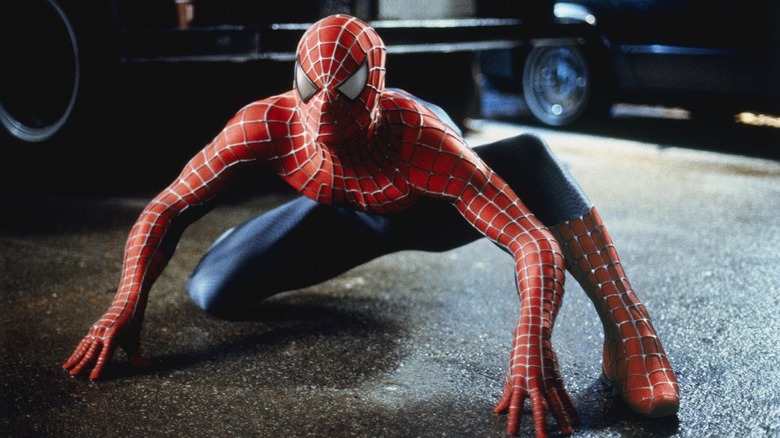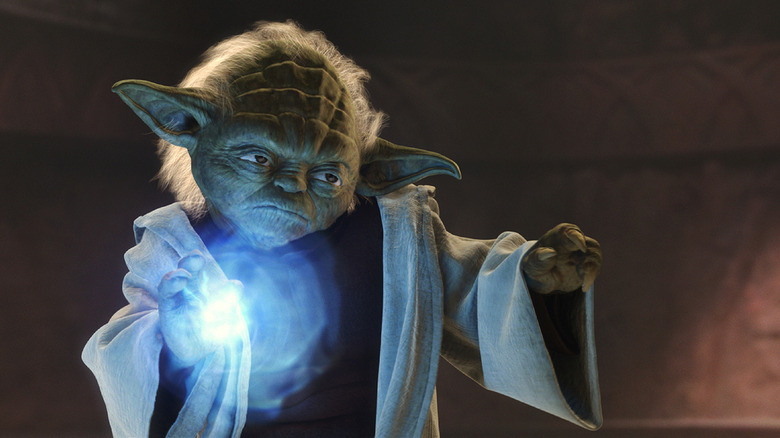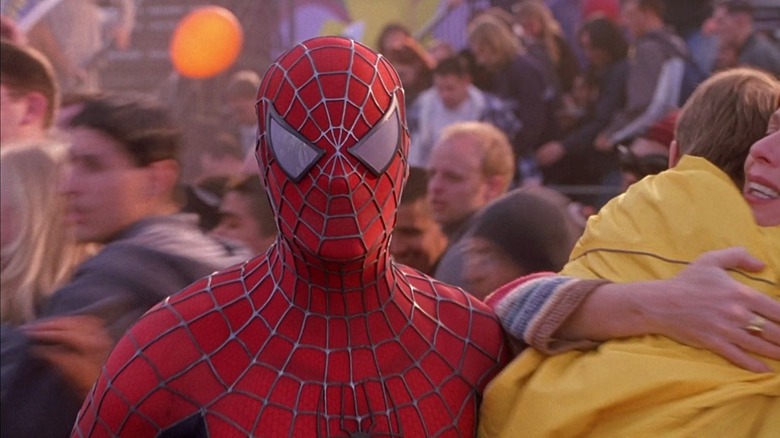Steven Spielberg Loved One Thing About Sam Raimi's Spider-Man
Those who were alert enough to be following cinema discourse in the early 2000s may recall the painful inflection point the medium had reached in terms of visual effects. A lot of productions were moving away from practical effects wholesale and leaning hard into CGI. Many audience members hated the technological shift, as CGI effects were proving to look plastic and unconvincing. While Steven Spielberg might have employed CGI carefully and effectively in his 1993 film "Jurassic Park," multiple films from the early 2000s were proving that an overuse of CGI made for truly awful film imagery.
A few examples include 2001's "The Mummy Returns," which features a terrible-looking CGI version of Dwayne Johnson, or 2002's "Star Wars: Episode II — Attack of the Clones" which features many animated characters as well as digital sets. Also released in 2002 was Sam Raimi's "Spider-Man," itself, in this writer's humble opinion, a mediocre film with lightweight CGI-based superhero action that critic Roger Ebert disliked. "Spider-Man as he leaps across the rooftops is landing too lightly," he wrote in his review, "rebounding too much like a bouncing ball. He looks like a video game figure, not like a person having an amazing experience." In the early 2000s, there was a cadre of angry film nerds (and I admittedly was among them) who decried Hollywood's over-reliance on CGI, preferring practical effects.
Ebert once interviewed Spielberg, and the two had a chance to talk about the director's 2002 film "Minority Report," which Ebert adored. Ebert also got to grill Spielberg about the then-modern state of visual effects, including how many filmmakers were moving further and further away from practical effects. Spielberg indicated that he while would always prefer to shoot on practical sets, he felt the CGI in "Spider-Man" was actually quite good. Specifically, he enjoyed the film's shimmering unreality and how it looked and felt more like a colorful fantasy.
Spider-Man, Star Wars, and CGI in 2002
Ebert told Spielberg that he got a lot of angry messages after the releases of "Spider-Man" and George Lucas' "Attack of the Clones," with filmgoers decrying their terrible digital visuals. Spielberg clarified that he wasn't interested — at least not yet — in making all-digital backgrounds for his live-action actors. Rather, he liked practical sets because actors could sink deeper into their characters when they have actual, physical things to interact with. In his own words:
"I really love George's 'Star Wars: Episode II.' I thought it was operatic–George's most accomplished movie. But I don't think I'll ever go to computer-generated sets like he does. I think when you build a set in the 3-D world and actors walk onto that set, they get stimulated. They get ideas. Tom Cruise got ideas about how to play John Anderton [from 'Minority Report'] because we built his house with four walls and a ceiling; every aspect was real. He felt at home there, and got ideas about Anderton's behavior. I'm sad for the day when sets will exist in cyberspace and not in real life."
Of course, Spielberg eventually became curious about digital filmmaking and, in 2011, made "The Adventures of Tintin," a wholly animated movie that used realistic motion-capture for its characters. He took a similar approach to 2016's "The BFG" and for 2018's "Ready Player One," the latter of which is handily his worst movie. Back in 2002, however, when CGI tech wasn't as sophisticated, the director felt it was better to stay away from its over-use.
Spielberg liked the unreality of Spider-Man
Spielberg actually liked the slightly clunky look of the CGI in Sam Raimi's "Spider-Man," however. He understood that "Spider-Man" took place in a fantasy world, and that its visuals were derived from the colorful panels in a comic book. As such, it was appropriate if animated characters weren't weighty or realistic. There should be an element of realism, Spielberg felt, but it's okay if you can see the seams a little. As he explained to Ebert:
"Sometimes on 'Spider-Man,' which I quite liked, I enjoyed the CGI effects that made Spider-Man's flying look like a comic book and not like reality. It put me back in all the Spider-Man comics I read growing up. Sam Raimi was trying to get that comic art look, and what it requires is that you make the live-action scenes with Tobey Maguire look as much like comic art as the CGI swinging of Spider-Man. The trick is to get those values to meet in the middle."
One could say the same for the smooth, unrealistic CGI in, say, "Harry Potter and the Sorcerer's Stone," which was released in 2001 and which was also set in a fantasy world. It's okay if a centaur looks shimmery and unreal because it's a magical creature, removed from reality.
A generation later, and Spielberg's attitudes have come to sound old-fashioned. For the last 15 years, most of the major effects-driven blockbusters have been filmed against green screens, with actors interacting with tennis balls on sticks. Computer animation has, of course, improved, but the overreliance on digital effects has opened all new cans of worms, including overworking VFX artists and bidding wars. But that's a story for another time.


